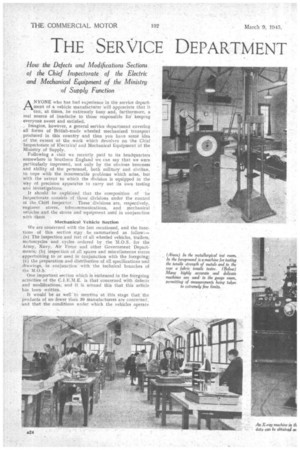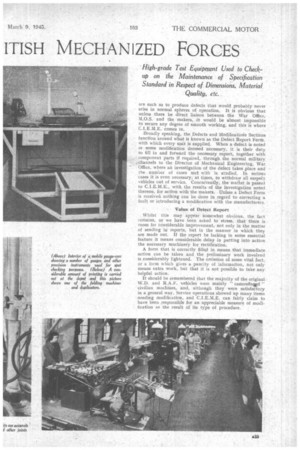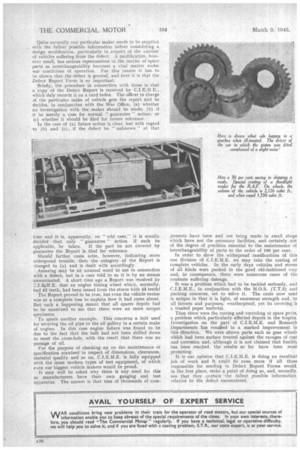THE SERVICE DEPARTMENT ITISH MECHANIZED FORCES
Page 26

Page 27

Page 28

If you've noticed an error in this article please click here to report it so we can fix it.
ANYONE who has had experience in the service department of a vehicle manufacturer Will appreciate that it can, at times, be ektremely busy and, furthermore, a• real source of headache to those responsible for keeping everyone sweet and satisfied.
Imagine, however, a general service department covering all forms of British-made wheeled mechanized transport produced in this country and then you have some idea of the extent of the work which devolves on the Chief Inspectorate of Electrical and Mechanical Equipment 'of the
Ministry of Supply. ' 'Following a visit we recently paid to its headquarters somewhere in Southern England we can say that we were particularly impressed, not only by the obvious keenness and ability of the personnel, both military and civilian. to cope with the innumerable problems which arise, but with the extent to which the division is equipped in the way of precision apparatus to carry out its own testing and investigations.
It should he explained that the composition of he Inspectorate consists at three divisions under the control of the Chief Inepector. . These divisions are, respectively, engineer stores,. telecommunications, and • mechanical vehicles and the stores and equipment used in conjunction
• with them • Mechanical Vehicle Section We are concerned with the laSt mentioned, and the 'uric. thins of this section may be summarized as follow:— (a') The inspection 'and test of all wheeled vehicles, trailers, motorcycles and cycles ordered by the M.O.S. for the Army, Navy, Air Force and other GoVernmen•t Departments;. (b) inspection of all spares and miscellaneous stores appertaining to or used in conjunction with the foregoing; (c) the preparation and distribution of all specifications and drawings, in conjunction with the technical branches of the 'AI .0. S.
One important section which is embraced in the foregoing activities of the C.I.E.M.E. is that concerned with defects and modifications, and it is around this that this article has been written.
It would be as well to mention at this stage that the ' Products of no fewer than 30 manufacturers are concerned, and that the conditions under which the vehiOles operate are such as to produce defects that would probably never arise in normal spheres of operation. It is obvious that unless there be direct liaison between the War Office, M.O.S. and the makers, it would be almost impossible to secure any degree of smooth working, and this is where C.I.E.M.E. comes in.
Broadly speaking, the Defects and Modificatimis Sections function around What is known as the Defect Report Form, with which every unit is supplied. When a defect is noted or some modification deemed necessary, it is their duty to fill in and forward the necessary report, together with component parts if required, through the normal military channels to the Director of Mechanical Engineering, War Office, where an investigation of the defect takes place and the number of cases met with is studied. In serious cases it is even necessary, at times, to withdraw all suspea vehicles out of service. Concurrently, the matler is passed to C.I.E.M.E., with the results of th.e investigation noted thereon, for action with the makers. Unless a Defect Form is received, nothing can be done in regard to correcting a fault or introducing a modification with the manufacturers.
• Value of Detect Report Whilst this may appear somewhat obvious, the fact remains, as we have been asked to stress, that there is room for Considerable improvement, not only in the matter of sending in reports, but in the manner in which they are made out. If the report be lacking in some essential feature it means considerable delay in putting into action the necessary machinery for rectification.
A form that is correctly fille,d in means that immediate action can be taken and the preliminary work involved is considerably lightened. The omission of some vital fact, or a form which gives a paucity of information, not only means extra work, but that it is not possible to take any helpful action. • It should be remembered that the majority of the originalW.D. and R.A.F. vehicles were mainly " camouflagfcl " civilian machines, and, although they were satisfactory in a general way, Service operations showed up many items needing modification, and C.I.E.M.E, can fairly claim to have been responsible for an appreciable measure of modification as the result of its type of procedure. Quite naturally any particular maker needs to be supplied with the fullest possible information before considering a design modification, particularly in respect of the number of vehicles suffering from the defect. A modification, however small, has serious repercussions in the matter of spare parts as interchangeability becomes a vital matter under war conditions of operation. For this reason it has to be shown that the defect is general, and here it is that the Defect Report Form is so important.
Briefly, the procedure in connection with these is that a 'copy of the Defect Report is received by C.I.E.M.E., which duly records it on a card index. The officer in charge . of the particular make of vehicle gets the report and he decides, in conjunction with the War Office, (a) whether an investigation with the maker should be made; (b) if it be merely a case for normal " guarantee" action; or (c) whether it should be filed for future reference.
In the case of (a) future action is clear, but with regard to (b) and (c), if the defect be " unknown " at that
time and it is, apparently, an " odd case," it is usually decided that. only " guarantee " action if such be
applicable, be taken. If the part be not covered by guarantee the Report is. filed for Should further cases arise, however, indicating more widespread trouble, then the category of the Report is -:hanged to (a) and is dealt with accordingly Amazing may be an unusual word to use in connection with a defect, but in a case told to us it is by no means unwarranted. A short time ago a Report was received by C.I.Ei.M.E. that an engine timing wheel which, normally, had 42 teeth, had been issued from the stores With 43 teeth?
• The Report proved to be true, but even the vehicle maker was at a complete loss to explain how it had come about. But such a happening meant that all spares depots had to be examined to see that there were no more unique specimens.
• To quote another example. This concerns a bolt used tor securing the oil pipe to the oil gallery in a certain make of engine. In this case engine failure was found to be due to the fact that the bolt had not been drilled down to meet the cross-hole, _with the result that there was no passage of oil. For the purpose of checking up on the maintenance of specification standard 'in respect of dimensions, clearances, material quality and so on, C.I.E.M.E. "is fully equipped with the most modern types of test equipment, of which even our biggest vehicle makers would be proud.
It may well be asked why there is any need for this as manufacturers have their own gauging and test apparatus. The answer is that tens of thousands of corn
portents have been and are being made in small shops which have not the necessary facilities, and certainly not of the degree of precision essential to the maintenance of interchangeability of parts to the order of 100 per cent. In order to show the widespread ramifications of this one division of C.I.E.M.E. we may take the crating of complete vehicles. In the early days vehicles and stores of all kinds were packed in the good old-fashioned way and, in consequence, there were numerous cases of the contents suffering damage.
It was a problem which had to be tackled seriously, and C.I.E.M.E., in conjunction with the M.O.S. (T.T.2) and packing concerns, set to solve it. The crate now used is unique in that it is tight, of enormous strength and, to all intents and purposes, weatherproof, yet its covering is a treated paper material.
Then there were the rusting and corroding of spare parts, a problem which particularly affected depots in the tropics. Investigation on the part of C.I.E.M.E. and Research Departments has resulted in a marked improvement in this direction. We were shown parts such as gear wheeli which had been surface treated against the ravages of rust and corrosion and, although it is not claimed that finality has been reached, the results so far have been most promising.
It is our opinion that C.I.E.M.E. is doing an excellent job of work and it could do even more if "all those responsible for sending in Defect Report Forms would, in the first place, make a point of doing so, and, secondly, see that they contain the fullest possible information relative to the defect encountered.





















































